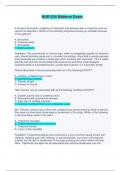Exam (elaborations)
NUR 634 Midterm Exam - Questions, Answers and Feedback
- Course
- Institution
NUR 634 Midterm Exam - Questions, Answers and Feedback A 55-year-old smoker complains of chest pain and gestures with a closed fist over her sternum to describe it. Which of the following diagnoses should you consider because of her gesture? A. Bronchitis B. Costochondritis C. Pericarditis D. Ang...
[Show more]



